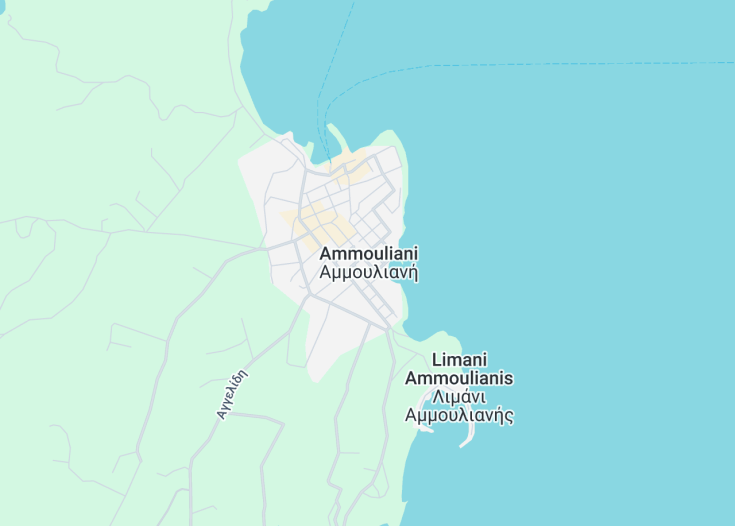Nestled in the azure waters of the Aegean Sea, Ammouliani is the only inhabited island in Halkidiki, Greece, boasting a unique charm that captivates travelers. This quaint island offers a blend of sandy beaches, crystalline waters, and traditionally hospitable locals.
The landscape is marked by lush olive groves and the typical Mediterranean flora. Ammouliani’s streets, lined with white-washed houses and flowery gardens, reflect a rich cultural heritage, ideal for those seeking tranquility amidst natural beauty.
To make the most of your visit, ensure to book accommodations in advance, particularly if planning a trip during the high summer season.
Explore beyond the popular beaches; the island’s small size makes it perfect for discovering hidden coves and picturesque nooks on foot or by bike.
Top things to do & see in Ammouliani
Select the following sights and activities to discover best tickets and tours available in Ammouliani.
Ammouliani: Gateway to Aegean Serenity
| Country | Greece |
| Time in Ammouliani | GMT+2 |
| Language spoken | Greek |
| Population | 547 (Hellenic Statistical Authority, 2021) |
| Currency | Euro (€, EUR) |
| Airports |
|
Ammouliani, located in northern Greece in the Halkidiki peninsula, is the only inhabited island in the region, gaining independence from the Vatopedi monastery in 1925 after housing monks for nearly a thousand years. Today, Ammouliani is celebrated for its crystal-clear waters, sandy beaches, and vibrant local culture, making it a unique destination within Greece.
Visitors are enchanted by its picturesque landscapes, which include lush Mediterranean greenery juxtaposed with the azure of the Aegean Sea. The island’s maritime tradition is evident in its delicious seafood cuisine, often enjoyed in small family-run taverns dotted along its coastline.
Historical landmarks, like the restored windmills and the ornate folklore museum, present a glimpse into its quaint rural life. Each year, tourists and pilgrims alike explore Ammouliani’s awe-inspiring sceneries, its religious sites, and its warm, inviting community. Despite its modest size of just 4.5 square kilometers, Ammouliani packs a wealth of natural beauty and historical intrigue, offering an ideal retreat for those seeking peace away from the hustle of mainstream tourist locales.
Where is Ammouliani?
Ammouliani is nestled in the North Aegean, just a short ferry ride from Tripiti in the Halkidiki Peninsula, Greece.
Distances:
| Route | Distance by car | Time by car |
|---|---|---|
| Thessaloniki to Tripiti | 78 miles / 125 km | 1 hour 45 minutes |
| Kavala to Tripiti | 100 miles / 161 km | 2 hours 20 minutes |
| Athens to Tripiti | 394 miles / 634 km | 6 hours 30 minutes |
What is Ammouliani famous for?
Ammouliani is renowned for offering an untouched paradise with serene beaches, crystalline waters and charming, picturesque village life that reflects Greece’s rich heritage and vibrant culture.
History
Early Settlement and Monastic Influence (Before 1923)
The history of Ammouliani, a charming island nestled in the Halkidiki region of Greece, traces back to ancient times when it was primarily uninhabited, serving as pastoral land for the monks of Vatopedi monastery, one of the oldest monastic communities on Mount Athos. The island’s strategic location in the Aegean Sea meant that it was occasionally used by these monks for seclusion and meditation. Over the centuries, the influence of the Mount Athos monasteries shaped its sparse early settlement patterns, leaving behind a legacy of tranquility and spirituality.
Population Exchange and Development (1923 – Mid 20th Century)
A significant turn in Ammouliani’s history occurred in 1923 with the population exchange between Greece and Turkey. Greek refugees from Asia Minor were resettled on the island, marking the beginning of its contemporary community. These new inhabitants cultivated the land, developed fishing as a main economic activity, and built the village which still exists today. The community thrived, maintaining strong cultural and traditional ties with their ancestral lands while blending with the local customs and environmental conditions of Ammouliani.
Modern Era and Tourism (Mid 20th Century – Present)
Post World War II, Ammouliani gradually transformed into a notable destination for tourists seeking tranquility and pristine natural beauty. The local economy saw a shift from predominantly fishing to tourism. Today, the island is renowned for its crystal-clear waters, fine sandy beaches, and hospitality, preserving its rich historical heritage while offering modern amenities to visitors. The balance between preservation and modernization has been key in shaping the current cultural and economic landscape of Ammouliani.
Visit Ammouliani
What to see and do in Ammouliani
Exploring Ammouliani offers a delightful experience for nature lovers and history enthusiasts alike. Visitors can admire the stunning coastline of the island, notably at beaches like Alikes and Megali Ammos, known for their turquoise waters and golden sands.
The traditional village, with its narrow alleys and picturesque architecture, provides a glimpse into the island’s past.
- Visit the Monastery of Panagia on the island for a touch of spiritual history.
- Take a boat tour around the island to explore secluded beaches and coves.
- Enjoy local cuisine in the quaint tavernas that offer fresh seafood and traditional Greek dishes.
Festivals and Events in Ammouliani
Ammouliani hosts several cultural and religious events throughout the year that reflect its rich heritage and vibrant community life. The Feast of St. Nicholas in December and the Panagia celebration in August are particularly noteworthy, drawing visitors and locals alike for festivities that include traditional music, dance, and communal feasting.
Best time to visit Ammouliani
The ideal time to visit Ammouliani is between late spring and early autumn, from May to October, when the weather is warm, and the sea is ideal for swimming. The summer months are particularly vibrant, offering sunny days and lively local events.
Is Ammouliani worth visiting?
Ammouliani is undoubtedly worth visiting for those who appreciate a blend of natural beauty, historical richness, and cultural authenticity.
The island offers a rare chance to experience untouched landscapes alongside a warm community atmosphere, making it a perfect getaway for relaxation and cultural immersion.










